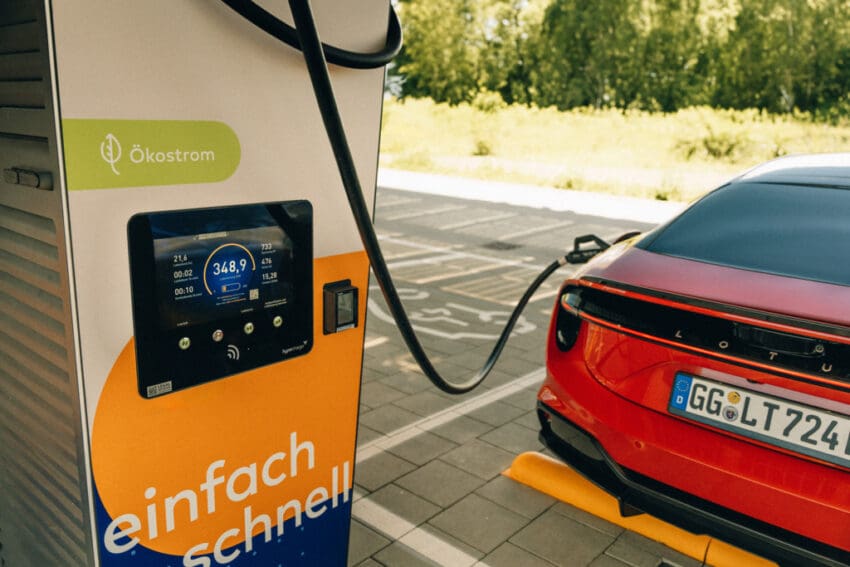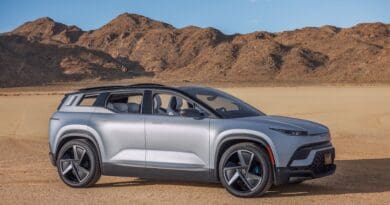
Lotus Emeya becomes world’s fastest-charging car
Lotus has announced that its new Emeya hyper GT car has set a new record for public charging, becoming the world’s first production car to support 400kW ultra-rapid charging.
Previously, the firm had said its newest all-electric model would offer the same 350kW standard as its Eletre SUV.
However, at a demonstration at its technical base in Germany, Lotus’s engineers demonstrated the car’s 400kW capability, which makes it the fastest-charging production car on sale.
EV Powered was at the demonstration where the Emeya charged its 102kWh battery from 10-80% in just 14 minutes on a commercially available charger. Previous tests had completed the industry-standard refill in 13 minutes 47 seconds.
The capability means that the long-range GT with up to 905bhp, can add 265 miles of range in less than quarter of an hour.
The next fastest-charging EV currently on sale is the Porsche Taycan, which operates at up to 320kW.
Lotus has achieved the charging landmark thanks to a new battery in the Emeya, which uses a different construction to that in the Eletre SUV, which supports up to 350kW charging.
Unlike the Eletre, which used a cooling panel beneath the battery cells, the Emeya uses an innovative side-cooling system which places cooling panels between the prismatic cells. This allows more efficient cooling, more stable charging speeds, and better management of battery swelling — a commonplace part of charging. It also features a cell-to-back battery structure, which means that 20% more cells can be packaged in the same space, compared to a standard module architecture.

As well as offering the fastest charging and one of the biggest batteries on the market, Lotus says it is taking other steps to ease range anxiety in the Emeya. Among these are onboard smart routing that will recommend charging locations and precondition the battery at the correct time, as well as providing information on nearby amenities such as restaurants. The same system will be offered in the Eletre via over-the-air updates. It has also partnered with Bosch on its charging network, giving access to 700,000 chargers across Europe through a single card.
Startling speed
While charging speeds are rarely a subject to set pulses racing, I confess I was genuinely impressed when witnessing the Emeya’s capabilities first-hand.
A quiet corner of a top-secret industrial estate in western Germany isn’t the most glamorous location to showcase a Lotus’s high-speed performance but, in the case of the Emeya’s battery capabilities, the Segula test centre near Dudenhofen served its purpose well.
After a couple of 140mph laps of the centre’s high-speed bowl to drain the battery to below 10%, we plugged our car – a 603bhp Emeya S – into the standalone charger and within one minute it was pulling down energy at 400kW.

I then watched it sit steadily between 395kW and 400kW until it reached 35%, at which point the speed slowed to help protect the battery. Even then, it continued to charge at more than 250kW all the way to 80%. Even as we ended the charging session at 82%, when speeds tail off, it was still operating at 200kW – more than most mainstream cars can manage at their very best. Independent testing has shown the Emeya’s average charge power between 10% and 80% is 331kW.
At its peak, the car’s on-screen display showed a charging speed equivalent to a jaw-dropping 1,105 miles per hour.
There are, of course, caveats to the Emeya’s performance. First you have to find a 400kW/600A charger, of which there are still very few. Then you have to make sure the car is in the correct condition, with around 10% of charge and the battery temperature preconditioned to around 32C.
Lotus says that the first problem is effectively a challenge to chargepoint operators, demanding they move their ultra-rapid game on to keep pace with the cars. It is also proposing its own solution in the shape of Lotus Flash Charging — a sister company which already produces high-powered chargers in China and has plans to bring its 450kW liquid-cooled chargers to Europe.
The other issues are common to any EV and require a little planning and the use of a simple onboard preconditioning function which most EVs, including the Emeya, offer.
There’s also the matter of cost associated with the more complex 800V architecture which allows such startling charging speeds. The Lotus starts at nearly £100,000 and the rival Porsche Taycan is priced from £86,500. Other existing or upcoming models that feature 800V underpinnings are the Audi Q 6 e-tron (from £63,500) and the Porsche Macan (£70,000).
The cheapest 800V car on sale right now is the Hyundai Ioniq 5, which starts at more than £43,000 and is limited to 240kW. That’s still quite a lot of money for a regular family car.
But, given how quickly the EV landscape has progressed in the last 10 years and how once-exclusive technology has trickled down, Lotus’s achievements give a tantalising glimpse of where more mainstream manufacturers could eventually be heading.





